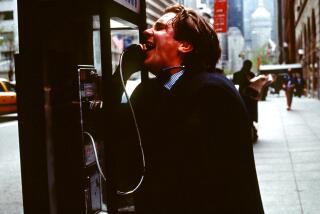Shamrock sees money in 3-D
- Share via
Three-dimensional movies have another believer: Roy E. Disney’s Shamrock Holdings Inc.
Shamrock’s Capital Growth Fund is expected to announce this week that it is putting $50 million into Real D, which has equipped more than 700 movie screens with 3-D systems.
The investment will give Shamrock and its partners a minority stake in the Beverly Hills company. Real D’s overall value is believed to be more than $200 million. Neither company would confirm the figure.
“We’ve been sniffing around the digital cinema space for a while,” Shamrock Capital Growth’s managing director, Stephen Royer, said. “It’s really the only viable mass-market solution.”
Based in Burbank, Shamrock Holdings is the investment vehicle for the family of Roy Disney, nephew of the late Walt Disney.
Shamrock’s bet comes as Hollywood has become enamored again with 3-D movies, which some cinema owners believe could help smooth their volatile box-office returns.
Today’s 3-D is nothing like the gimmicky days of cheesy monster flicks watched through green-and-red glasses. Advances include polarized glasses -- in only one shade -- that ensure each eye sees only the image intended for it.
With the number of screens capable of showing 3-D films rising, studios are committing to shooting more features that way.
Walt Disney Co.’s animated “Meet the Robinsons” is scheduled to open March 30 on as many as 3,500 screens. About 650 of those will show the movie in 3-D, the widest such release to date, Real D Chief Executive Michael V. Lewis said.
Disney recently struck a deal for animated motion-capture films in 3-D by “The Polar Express” director Robert Zemeckis. “Titanic” director James Cameron has said he will work in 3-D from now on, including on “Avatar,” a big-budget fantasy picture due in 2009 from 20th Century Fox.
Last week, DreamWorks Animation SKG Inc. said its entire slate would be shot in 3-D starting in 2009.
“This is the greatest opportunity for movies and for the theatrical exhibition business that has come along in 30 years,” DreamWorks Animation CEO Jeffrey Katzenberg said.
Lewis, a former investment banker, promises 1,000 Real D screens before the November release of Paramount’s “Beowulf,” also by Zemeckis.
Real D’s technology was enhanced in 2005 by the purchase of StereoGraphics of San Rafael, Calif.
One area Real D aims to still improve is the brightness of the 3-D images. A lot gets lost in the process, which is something Real D hopes to correct by acquiring Boulder, Colo.-based ColorLink Inc.
ColorLink works with projection companies and also in the home-theater market, with components in high-definition TV sets and DVD players that enhance lighting. That purchase boosted the number of Real D employees by 55.
For cinemas, adding 3-D capability makes more sense as they convert to digital systems, which produce sharp images and don’t require expensive film prints. If a theater already has digital projection, an upgrade to a Real D system costs about $40,000 to $50,000 upfront, with annual fees of about $25,000.
But the per-screen returns have run double to triple those of regular films, said digital cinema consultant Michael Karagosian, whose clients include the National Assn. of Theatre Owners.
Although competing technologies are in the works, including one announced last week by Dolby Laboratories Inc., “Real D is the only one that’s available commercially today,” Karagosian said.
Real D also is looking to use its technology to show sporting events and concerts at times when theaters would otherwise sit empty.
Studio executives believe that with theaters converting to digital systems anyway, 3-D’s potential will expand still further.
“We’re certainly excited about the prospect of 3-D, and when digital cinema becomes more dominant it seems like a very big opportunity for everyone,” said Jeff Blake, vice chairman of Sony Pictures Entertainment.
More to Read
The biggest entertainment stories
Get our big stories about Hollywood, film, television, music, arts, culture and more right in your inbox as soon as they publish.
You may occasionally receive promotional content from the Los Angeles Times.










